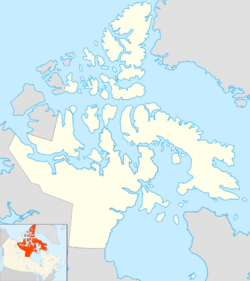Île Marc facts for kids
| Geography | |
|---|---|
| Location | Northern Canada |
| Coordinates | 75°51′N 103°35′W / 75.850°N 103.583°W |
| Archipelago | Queen Elizabeth Islands Canadian Arctic Archipelago |
| Area | 56 km2 (22 sq mi) |
| Administration | |
|
Canada
|
|
| Territory | Nunavut |
| Demographics | |
| Population | Uninhabited |
Île Marc is a small, uninhabited island located in the Arctic Archipelago of Canada. It is part of Nunavut, Canada's largest and northernmost territory. This island can be found in the Boyer Strait, positioned just south of Massey Island and to the northwest of Alexander Island.
Contents
Where is Île Marc?
Île Marc is situated in the vast Canadian Arctic Archipelago, a huge group of islands in northern Canada. It belongs to a smaller group of islands known as the Queen Elizabeth Islands. These islands are known for their cold climate and remote locations.
Location Details
The island lies specifically within the Boyer Strait. This strait is a narrow passage of water that separates different landmasses. To the north of Île Marc, you'll find Massey Island. To its northwest, the larger Alexander Island is located. These geographical features help define Île Marc's exact spot on the map.
Island Size and Features
Île Marc is a relatively small island. It covers an area of about 56 square kilometers (approximately 21.6 square miles). To give you an idea, this is roughly the size of a medium-sized town or a large park.
Uninhabited Lands
Like many islands in the far north, Île Marc is uninhabited. This means no people live there permanently. The harsh Arctic climate, with its extremely cold temperatures and long winters, makes it difficult for humans to settle.
Île Marc is part of Nunavut, which is one of Canada's three territories. Nunavut is a massive region, mostly made up of islands and a large mainland area. It was created in 1999 to give the Inuit people more control over their traditional lands.
The Qikiqtaaluk Region
Within Nunavut, Île Marc is located in the Qikiqtaaluk Region. This is the largest and northernmost administrative region of Nunavut. It includes many of the Arctic islands and is known for its unique wildlife and stunning icy landscapes.



